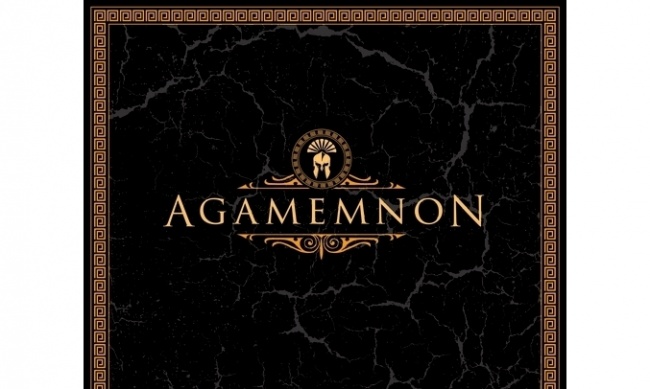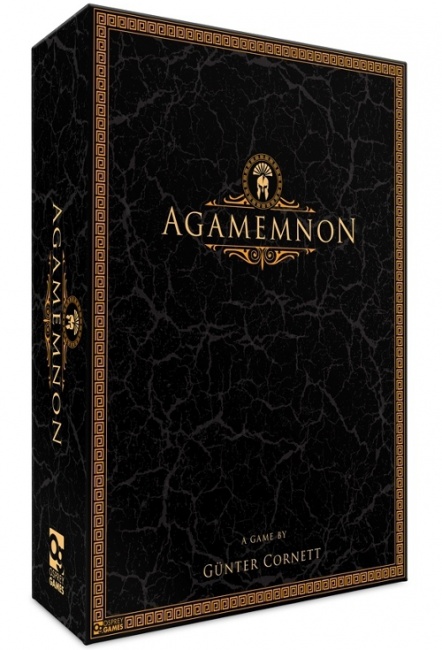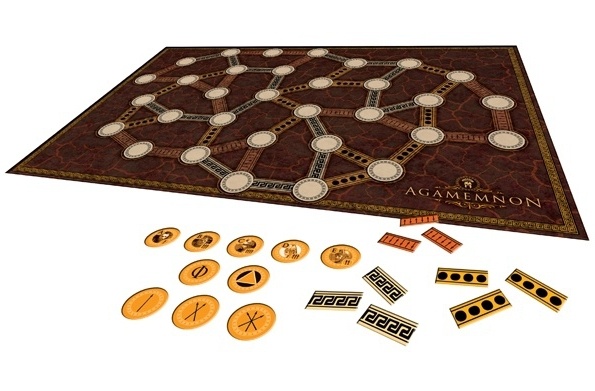Agamemnon
Publisher: Osprey Games
Release Date: August 25, 2016
Price: $24.00
Game Designer: Günter Cornett
Format: Boardgame
Number of players: 2
Game Length: 15-20 minutes
Age Rating: 12 and up
ISBN #: 978-1-4728-1728-0
ICv2 Rating: 3 stars out of five
With the popularity of European-style board games, we have become accustomed to games in which the theme seems a pasted-on affair in reality unrelated to the game mechanics themselves. In many games, the theme can scarcely conceal what is virtually an abstract strategy game, seasoned with a pinch of randomness. Agamemnon falls squarely into this category.
Summary: The theme of Agamemnon is, naturally, the Trojan War, which made that Mycenaean king famous. Two players are cast in the role of Greek gods, manipulating the twisted threads of fate to benefit their chosen side, the Greeks or the Trojans, achieve victory.
But once you sit down to play, you can safely ignore that if you choose. The game is a far more strategic and abstract affair in which players place three types of tokens in order to control the "threads" that make up the game map, or which allow direct manipulation of the "loom of fate" itself. In the end, the player who is able to control the most of these threads is victorious.
Originality: Viewed as a sort of area control game, Agamemnon doesn’t thrust too deeply into unknown territory. What makes it stand out, though, is the nature of the loom of fate. As the different threads are twisted around each other and subject to change over the course of the game, it is not always obvious how the various spaces on the board are going to relate to one another. Players must constantly assess the relative value of each thread as the game evolves, which keeps the play competitive to the end.
Presentation: I am very much enjoying Osprey’s new style of game packaging. The box is sturdy and elegant, hinged so it opens like a book while closing tightly enough that you can shelf it standing up without it falling open like so many other game boxes do. The interior packaging does a good job of keeping the components in place whether the game is shelved, lying down, or standing up as well, which I appreciate.
However, the black-and-gold graphics on the outside of the box are, frankly, dull and uninspiring. I can see that the goal was to create something elegant, perhaps reminiscent of a book of classic literature. But the result is that the box does little to attract attention. The palette of the components is similarly subdued, and in poor light some of the colors are hard to distinguish (is that red, red-orange, or orange?). While this is not a huge obstacle to playing the game as the components have symbols as well as colors, it sadly just doesn’t grab the attention the way brighter colors or illustrations would.
Quality: Osprey has been quietly cultivating a tradition of quality components, and Agamemnon continues this trend. The box, as mentioned above, is excellent. The board is good, heavy stock, and the tokens are plenty thick enough without being excessively heavy or clumsy. The player aid cards have a good stiffness to them, and the rules are full-color and glossy.
The rules, however, are something of an issue for me. There were a number of elements in the game that I thought were not covered sufficiently, and it took some puzzling-out in a few places before I was comfortable with them. The examples are sparse, and don’t cover every in-game situation that came up even during our first few plays. The rules pamphlet has plenty of white space that, I think, would have been better used making the rules as clear and complete as possible.
Marketability: While the quality of components and the depth of gameplay do a lot to justify the price tag, I’m concerned that the subtle nature of the graphics and packaging may result in a lot of potential customers overlooking this title. And while Greeks and Trojans have long been a gaming staple, the relative unpopularity of abstract strategy games in the U.S. likely means that Agamemnon probably won’t get the attention that it deserves.
Overall: And that is unfortunate, because Cornett has created a clever, tight little strategy game that packs surprising depth into its 15 minute playing time. The interaction between the different types of threads and the variable methods for taking control of them, not to mention the fact that the knot of threads WILL change over the course of the game, really rewards careful and strategic play. The game’s one random element--the order in which each player draws their pool of tokens--helps keep things interesting and forces you to constantly adjust your strategy through the entire game. Every time we played, the scores were very close, keeping the tension up to the very last play.
Agamemnon may not require the cleverness of Odysseus to play, but that would certainly help one achieve victory in this surprisingly deep strategy game. A great choice for beginning or end of game night filler, sadly not helped by Osprey’s usually excellent graphics department. I give this game 3 out of 5.
--William Niebling

ICv2 Stars: 3 (out of 5)
Posted by William Niebling on September 7, 2016 @ 4:30 am CT




